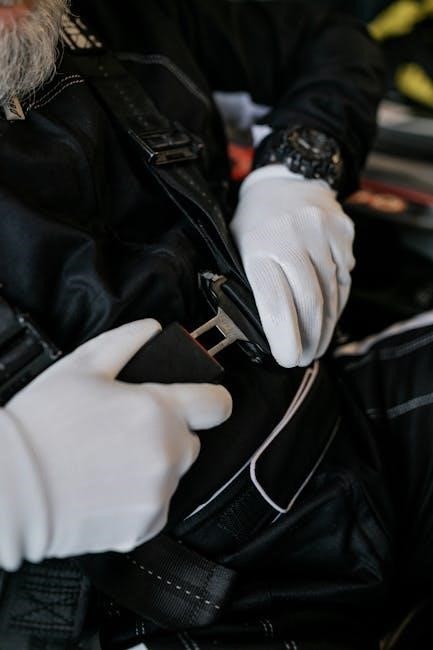The Safety First Car Seat Instruction Manual is your essential guide to ensuring your child’s car seat is installed and used correctly. It provides vital information on safety features, proper installation, and care. Always refer to this manual to maximize your child’s safety while traveling. For assistance, contact customer service at 1-800-544-1108 or visit the official Safety First website for downloadable resources.
The Importance of Safety in Car Seats
Car seats are essential for safeguarding children during travel, as they significantly reduce the risk of injury in the event of a crash. Proper installation and use of car seats are critical to ensure maximum protection. Always refer to the instruction manual to understand safety features and guidelines specific to your car seat model. Ignoring these guidelines can compromise your child’s safety. Regularly inspect your car seat for damages, recalls, and proper fitment. Remember, a well-maintained and correctly installed car seat is a life-saving measure for your child. Never use second-hand car seats without verifying their condition and history. Additionally, stay informed about age and weight limits to ensure the car seat remains suitable for your child’s needs.
Why Follow an Instruction Manual?
Failing to follow the Safety First car seat instruction manual can compromise your child’s safety. The manual provides critical information on proper installation, usage, and maintenance to ensure the car seat functions correctly. It outlines specific guidelines for securing the seat, adjusting harnesses, and transitioning between modes (rear-facing, forward-facing, or booster). The manual also includes essential safety warnings and precautions to prevent potential hazards. By adhering to these instructions, you ensure your child is protected according to industry standards. Always consult the manual before making adjustments or replacements. Ignoring these guidelines can lead to improper fitment, which may increase the risk of injury during abrupt stops or collisions. Make it a habit to read and follow the instruction manual carefully for your child’s safety and well-being.
Quick Overview of Safety Features
Safety First car seats are designed with advanced safety features to protect children during travel. These include rear-facing, forward-facing, and booster modes for versatility across different age groups. Adjustable headrests and energy-absorbing foam provide superior crash protection, while side impact protection enhances security during collisions. The included harness system ensures a secure fit, properly restraining your child in all situations. Additionally, designs like the MultiFit EX Air offer extended harness capabilities for growing children. These features work together to meet or exceed safety standards, ensuring your child travels safely and securely in any vehicle. Always review these features in the manual to understand their proper use and maintenance.

How to Locate Your Car Seat Instruction Manual
How to Locate Your Car Seats Instruction Manual
To find your Safety First Car Seat Instruction Manual, check the product’s Amazon page or visit the official Safety First website. Manuals can also be downloaded online or requested by contacting customer service at 1-800-544-1108 for a mailed copy. Always ensure you have the most accurate and up-to-date guide for safe use.
Official Safety First Website Resources
The official Safety First website is a valuable resource for car seat owners. Visit safety1st.com to access downloadable instruction manuals, installation guides, and troubleshooting tips. Find specific resources for models like the Grow and Go 3-in-1 or MultiFit EX Air 4-in-1 car seats. Check the website for product registration, safety updates, and recalls. It is also a primary source for accurate and updated information to ensure your car seat meets safety standards.
Contacting Customer Service for Support
If you need assistance regarding your Safety First car seat, contacting their customer service team is highly recommended. You can reach them directly at 1-800-544-1108 during business hours. Their support team is trained to assist with installation questions, troubleshooting, and general inquiries. Visit the official Safety First website for updated contact information and additional resources. Always have your car seat model number, such as the Grow and Go 3-in-1 or MultiFit EX Air 4-in-1, ready to ensure personalized assistance. Customer service can also help you download manuals or locate specific support materials, ensuring your car seat is securely installed and used correctly. Don’t hesitate to reach out for expert advice to keep your child safe while traveling.
Downloading Manuals Online
To download your Safety First car seat instruction manual, visit the official Safety First website. Look for the car seat model you own, such as the Grow and Go 3-in-1 or MultiFit EX Air 4-in-1, to find the corresponding manual. Pages like safety1st.com/car-seats often provide direct links to user manuals. Manuals are typically available as PDF files, which can be downloaded and saved for future reference. Ensure your internet connection is stable to avoid incomplete downloads. If the manual is not immediately visible, use the search function to locate it. Always bookmark the page for quick access. Having the manual on hand ensures you can quickly reference safety guidelines and installation steps whenever needed.

Safety First Car Seat Installation Guide
The Safety First Car Seat Installation Guide ensures safe travel for your child. Follow the manual’s instructions meticulously for proper setup and secure installation. If misplaced, download the guide from Amazon or the official Safety First website. Always prioritize correct installation techniques for maximum protection.
Step-by-Step Installation Process
Refer to your Safety First car seat instruction manual for a detailed step-by-step guide. Start by determining the appropriate mode for your child’s age and weight (rear-facing, forward-facing, or booster mode). Secure the car seat using the vehicle’s seat belt or LATCH system. Adjust the harness straps to ensure a snug fit. Check that the car seat is properly compressed and fits securely in the vehicle. Follow additional instructions for stabilizing the base or adding accessories. Always test the car seat for movement to ensure it is secure. Regularly review the manual to ensure compliance with age, weight, and height guidelines. Tighten straps and adjust headrests as needed for a proper fit. Familiarize yourself with the manual’s safety warnings and care tips for optimal performance. If unsure, consult the manual or seek professional assistance.
Using Safety Belts and Anchors Properly
Proper use of safety belts and anchors is critical for securing your child’s car seat. Always refer to your Safety First instruction manual for specific guidance. Begin by positioning the car seat according to the manufacturer’s recommendations. Use either the vehicle’s seat belt or the LATCH system to secure the seat firmly. Ensure the safety belt is routed through the designated path and locked tightly. Double-check the anchors to confirm they are correctly engaged and aligned. Adjust the harness straps to match your child’s size and weight. Follow the manual’s instructions for testing the fit and ensuring the car seat is snug and stable. If you encounter difficulties, consult the manual or contact customer service for additional support. Proper installation minimizes the risk of movement and maximizes safety for your child during travel.

Understanding Safety First Car Seat Models
Safety First offers versatile car seat models like the Grow and Go 3-in-1, MultiFit EX Air 4-in-1, and OnBoard 35 LT. These models cater to various needs, from rear-facing infants to booster seat transitions, ensuring safe travel for growing children. Always follow theManual for model-specific instructions to ensure optimal safety and usage.
Safety First Grow and Go 3-in-1 Car Seat
The Safety First Grow and Go 3-in-1 car seat is a versatile model designed to adapt to your child’s growth, offering rear-facing, forward-facing, and booster modes. The manual provides detailed instructions for transitioning between modes based on your child’s age and weight. It emphasizes proper installation and belt usage to ensure maximum safety. Always refer to the user manual, available online or from the manufacturer, for accurate guidance on adjusting the seat for each mode. The Grow and Go 3-in-1 is designed to provide reliable protection throughout different stages of your child’s development.
Safety First MultiFit EX Air 4-in-1 Car Seat
The Safety First MultiFit EX Air 4-in-1 car seat is a versatile and advanced model designed to accommodate children at various stages of development. The manual provides detailed instructions for installing and adjusting the seat, ensuring optimal safety and comfort. It highlights features like the padded harness and compact design, making it suitable for everyday use. Parents can download the manual from the official Safety First website or access it as a PDF file. Always follow the guidelines for proper installation and maintenance to ensure the seat functions effectively for rear-facing, forward-facing, booster, and no-back configurations. The MultiFit EX Air is engineered to provide reliable protection while adapting to your child’s growth, making it a valuable addition to any family.
Safety First OnBoard 35 LT Car Seat
The Safety First OnBoard 35 LT car seat is a rear-facing-only model designed for newborns and young infants, providing optimal protection and comfort. Its compact design and lightweight frame make it easy to carry and install. The adjustable headrest and padded harness ensure a snug fit, while the machine-washable cover allows for easy cleaning. Always follow the instructions in the user guide for proper installation and care. The manual can be downloaded as a PDF from the Safety 1st website or accessed online for future reference. This car seat is perfect for parents looking for a reliable and convenient solution for their child’s car travel.

Safety Warnings and Precautions
Failure to follow safety warnings and labels in the instruction manual can result in serious injury or death. Always check labels and adhere to guidelines. Never use an expired or damaged car seat. Keep the manual for future reference and review regularly. Contact Safety First for support if you need assistance accessing the manual.
Important Warnings from the Manual
Important warnings from the Safety First car seat instruction manual emphasize the necessity of adhering to guidelines to prevent serious injury or death. Proper installation and usage are critical. Never use an expired or damaged car seat, as this can compromise safety. Always follow the age, weight, and height guidelines specified in the manual. Check all labels for expiration dates and warning information. Avoid making any modifications to the car seat, as this can void safety certifications.
Ensure the car seat is tightly secured in your vehicle and that the harness fits snugly around your child. Do not alter or remove any parts of the car seat. If you encounter difficulties, consult the manual or contact Safety First customer service for assistance. Keep the manual accessible for future reference and periodically review its contents to ensure compliance with safety standards.
How to Read and Understand Labels
Understanding the labels on your Safety First car seat is crucial for ensuring proper usage and maximizing safety. These labels provide essential information, including weight limits, installation instructions, warnings, and expiration dates. Always inspect the labels before and after each use to ensure compliance with safety standards. Labels are typically located on the car seat base, harness straps, and other key components. Pay close attention to any special instructions or symbols that indicate proper orientation or adjustments. If you encounter unclear or unfamiliar terms, refer to the instruction manual for further clarification. Properly interpreting these labels ensures your child’s car seat meets safety requirements and reduces the risk of accidents or injuries.
Regularly check for updates or additional information provided by Safety First, as labels may contain critical warnings or recalls. If labels become faded, torn, or unreadable, contact customer service to request replacements. Understanding how to read and act on these labels is a fundamental step in maintaining your child’s safety while traveling.

Best Practices for Car Seat Maintenance
Regular cleaning and inspecting your Safety First car seat ensures it remains safe and effective. Use mild soap and water for cleaning, avoid harsh chemicals. Check for wear and tear, loose parts, or damaged harness straps. Replace worn components promptly to maintain safety standards. Store your car seat in a cool, dry place when not in use to prolong its lifespan.
Regular Cleaning and Sanitizing Tips
Regular cleaning and sanitizing of your Safety First car seat are essential for maintaining hygiene and ensuring your child’s safety. Use mild soap and warm water with a soft cloth to clean the fabric surfaces gently. Avoid harsh chemicals or abrasive scrubbers, as they may damage the seat material. Clean the harness straps frequently, ensuring they are free from dirt and grime. Always dry the seat thoroughly after cleaning to prevent mold or mildew growth.
For spills or stains, act promptly to prevent staining. Use a damp cloth to blot the area and clean it as soon as possible. Inspect the car seat regularly for wear and tear, especially around the harness and buckles. Replace any worn-out components to maintain safety standards. Always follow the manufacturer’s guidelines for cleaning and sanitizing to ensure your car seat remains in optimal condition for your child’s comfort and protection.
Replacing Parts and Components
Over time, certain parts of your Safety First car seat may wear out or become damaged, requiring replacement. Always refer to the instruction manual to identify which components need replacement and how to do it safely. For example, harness straps, padding, and buckle mechanisms may require updating to maintain functionality and safety standards. Visit the official Safety First website or contact their customer support to purchase genuine replacement parts. Using non-authentication parts can compromise the car seat’s effectiveness. Before replacing any components, consult the manual to ensure proper installation and avoid misuse. Regularly inspect the car seat for signs of wear and tear, and replace parts promptly if needed. This will help ensure your child’s safety and extend the life of the car seat. Always follow the manufacturer’s guidelines when replacing parts or components to maintain optimal performance and safety.

Ensuring Proper Fit for Children
Ensure the car seat fits your child’s age and weight requirements. Proper installation and snug fit are crucial for safety. Adjust straps according to the manual to ensure a secure and comfortable fit.
Age and Weight Guidelines
Always follow the manufacturer’s age and weight limits specified in the Safety First car seat instruction manual to ensure your child’s safety. Rear-facing seats are recommended for infants up to 2 years old or until they reach the seat’s weight limit. Forward-facing seats are designed for children who have outgrown rear-facing and are between 2 to 7 years old. Booster seats are intended for older children who have surpassed the forward-facing weight limit but are not yet tall enough for adult seat belts. Refer to your manual for model-specific guidelines and visit the official Safety First website for detailed instructions. Never use a car seat beyond its expiration date or weight capacity, as this can compromise safety and protection.
Adjusting for Maximum Comfort and Safety
To ensure your child’s comfort and safety, carefully follow the instructions in the Safety First instruction manual for adjusting the car seat. Start by checking the harness straps; they should be snug enough to pass the pinch test. Adjust the headrest to fit your child’s height, ensuring it provides proper support; If your car seat has adjustable shoulder straps or a canopy, position them correctly to enhance comfort and reduce distractions during travel. Always ensure the car seat is at the correct angle to support your child’s neck and back. For optimal comfort, use any additional padding or accessories recommended by the manufacturer. Regularly monitor the fit and adjust as needed to keep your child secure and comfortable throughout their journey. Always refer to the manual for specific adjustments tailored to your car seat model.
Transitioning Between Car Seat Types
When transitioning between car seat types, refer to the Safety First instruction manual to ensure a smooth and safe change. Issues like height, weight, and age guidelines must align with the new car seat’s specifications. For instance, the Safety First Grow and Go 3-in-1 seat transitions from rear-facing to forward-facing to booster mode, as detailed in its user manual. Always adjust straps, headrests, and harnesses according to the manual to maintain proper fit. Double-check the installation using the vehicle’s safety belts and anchors. If unsure, consult the manual or seek professional guidance. Transitioning seamlessly ensures your child remains comfortable and secure throughout their growth stages. When changing car seats, ensure the new model complies with current safety standards and instructions. Always keep the manual handy for reference. Transitioning should be a planned process to guarantee continuity in your child’s safety.

Advanced Installation Techniques
When dealing with advanced installation techniques for Safety First car seats, always consult the instruction manual to ensure proper setup. Use the vehicle’s LATCH system or safety belts as indicated, adjusting the seat securely for a snug fit. Test the fit by pulling the car seat firmly at the belt path—if it moves more than an inch side to side or front to back, it’s not secure. For larger vehicles, consider using the manual’s vehicle compatibility charts to find the best installation points. Advanced features like recline adjustments and tether anchors should be utilized according to the manual. If unsure, refer to the Safety First website or contact customer service for support. Always prioritize secure installation to ensure your child’s safety during travel.
Maintenance and Troubleshooting Tips
Regular maintenance is crucial to ensure your Safety First car seat remains in optimal condition. Always refer to the instruction manual for specific guidelines on cleaning and caresanitizing. Wipe the car seat and its components with mild soap and water, avoiding harsh chemicals that could damage the materials. Replace any worn or damaged parts, such as harness straps or padding, immediately to maintain safety standards. If you notice issues like incorrect fitting or malfunctioning features, consult the manual forTroubleshooting steps. Always follow the warnings and labels provided to prevent potential hazards. For ongoing care, store the car seat in a dry place and avoid exposing it to extreme temperatures. If problems persist, contact Safety First customer service for expert support.

Educational Resources and Support
To help parents navigate car seat, Safety First provides a range of educational resources. Visit the official safety1st.com website for downloadable manuals, videos, and installation guides. The site also offers training resources to ensure proper use of car seats. For additional support, contact customer service at 1-800-544-1108 to request a physical manual or ask questions. Online forums and parenting communities often share practical tips and troubleshooting advice. Stay informed about the latest safety features and updates by referring to the official resources regularly, ensuring your child’s car seat always meets safety standards.

Environmental and Disposal Guidelines
When it’s time to dispose of your Safety First car seat, follow these environmentally responsible guidelines. Recycling is always the best option; check if your local recycling facility accepts car seats or visitthe manufacturer’s website for recycling programs. If recycling is not possible, consult local regulations for proper disposal; Consider donating gently used car seats to organizations or families in need. If the seat is damaged or expired, never donate it; instead, dispose of it responsibly. Be mindful of reusing materials, such as padded covers or straps, for other purposes. Always prioritize safe and eco-friendly disposal methods to protect both the environment and future generations.



Leave a Reply
You must be logged in to post a comment.